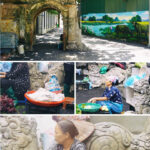Participating in the “6th Cultural Development and Elegant and Civilized Hanoian Building Press Awards 2023” competition, the team of authors including Tran Hong Van, Hoang Le Quyen, Doan Anh Tuan, and Nguyen Huu Tiep from Hanoimoi newspaper remarkably secured the A prize with their work “Rural Architecture: What Lies Ahead in the Future?” for five consecutive parts. The Hanoi Department of Culture and Sports’ Electronic Information Portal is honored to introduce the third part of this piece to our extensive readership!

Rural areas in Hanoi and, by extension, Vietnam as a whole are undergoing rapid transformations. It’s not just the architectural infrastructure and landscapes that are changing; the higher-level values regarding lifestyle, work, and the socio-economic activities of many rural areas are also experiencing significant shifts. Faced with the “urbanization storm,” craft villages and traditional villages in Hanoi are grappling with substantial changes.
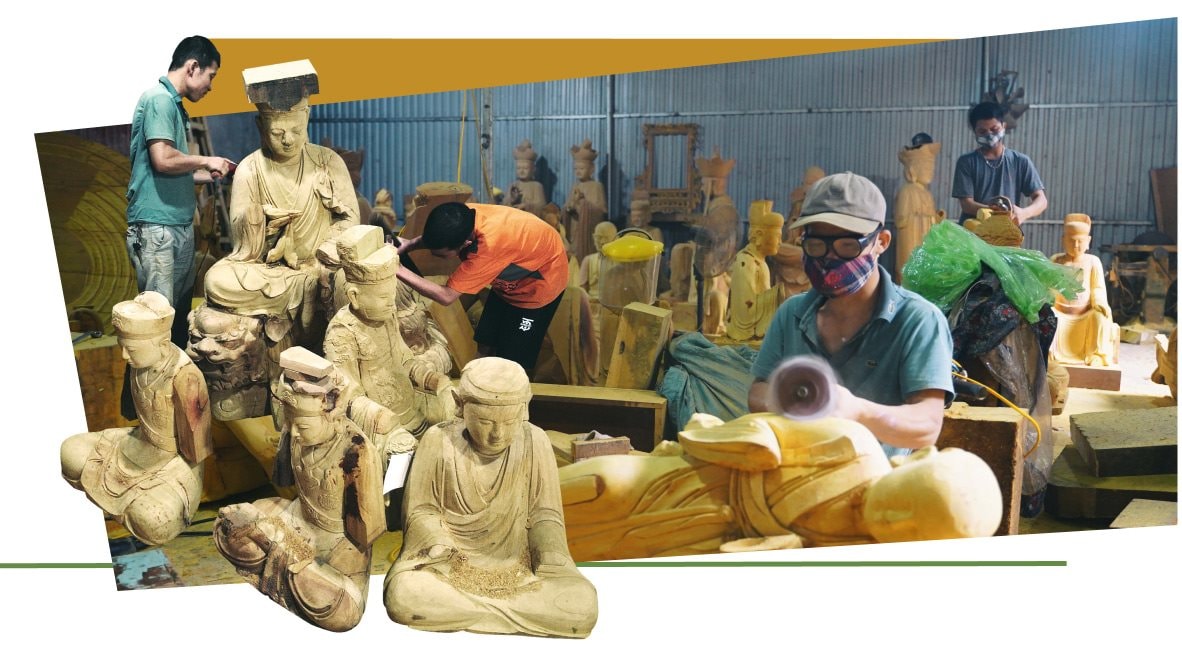
Son Dong Commune (Hoai Duc District), like many other craft villages in Hanoi, is wrestling with the narrative of preserving traditional crafts and conserving the landscape and refined lifestyle within the confined spaces of rural villages. This area has undergone considerable changes in both architecture and culture.
Renowned as a village with a myriad of crafts, including silk farming dating back to the Hai Ba Trung era, the most robust and famous craft in Son Dong today is wood carving, sculpting Buddha statues, and crafting ceremonial items.
Artisans in the Son Dong craft village (Son Dong commune, Hoai Duc district) often work in tight spaces. Chairman of the People’s Committee of Son Dong commune, Nguyen Viet Hung, expresses concern that Son Dong, with its 50 recognized artisans, is considered one of the exemplary craft villages not only in Hanoi but also nationwide. The urbanization pressure, rapid population growth, spontaneous construction increase, and traditional crafts flourishing, but households lacking sufficient land for expanding production, pose numerous challenges. The village is grappling with pollution, urban architecture disruption due to multi-story houses, and many households turning living spaces into workshops.
According to Mr. Nguyen Viet Hung, the local authorities have proposed and advocated for a separate production zone planning to separate residential areas from the craft village. However, this plan remains “pending” until now. According to the general development plan for the capital, Son Dong is designated as urban land, implying that the traditional craft village of the commune is likely to be “erased.”
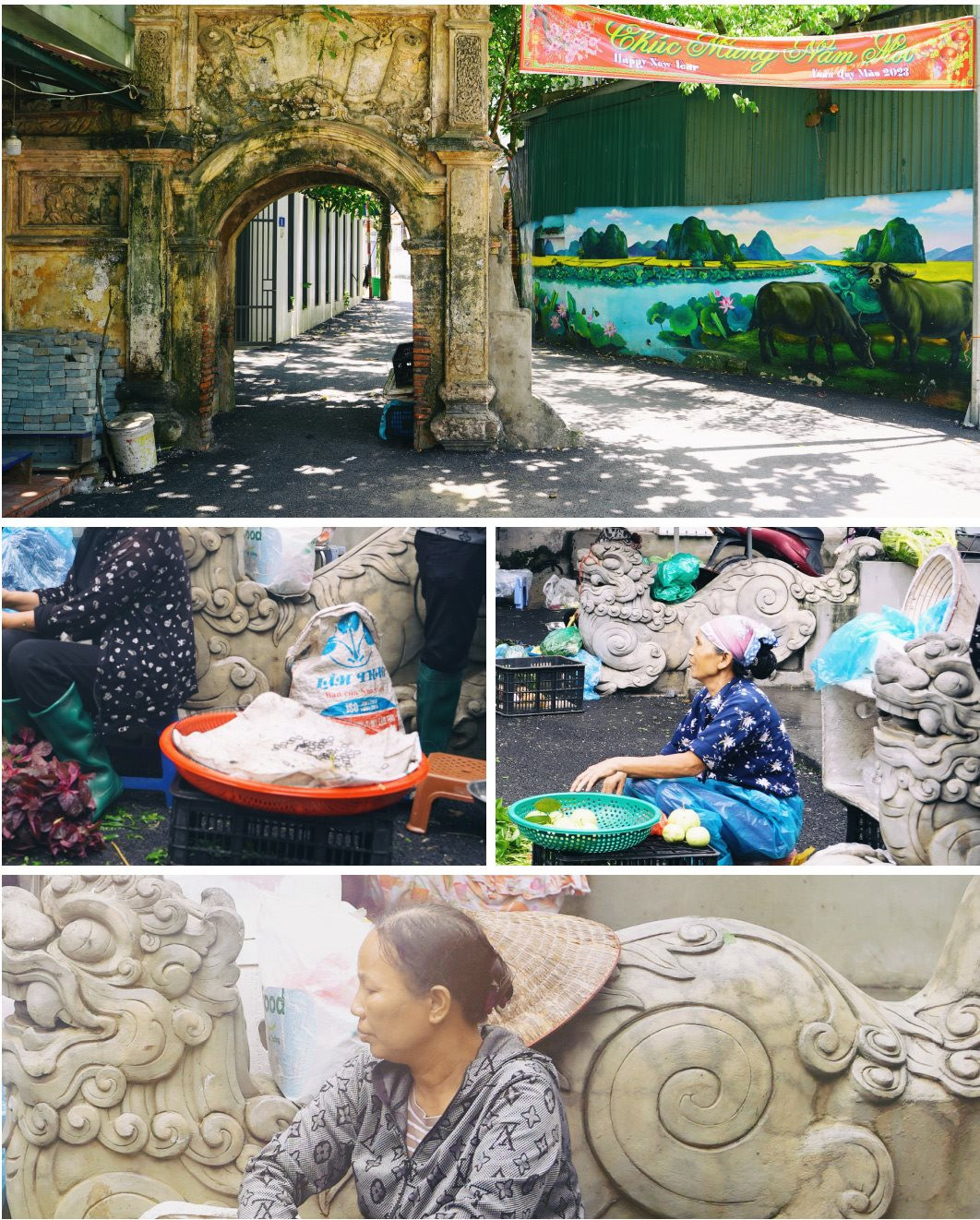

The gathering market encroaching on the space of ancient relics (Photo taken in Son Dong village on the morning of August 5, 2023)
Preserving and revitalizing living spaces to make each craft village and traditional trade village a desirable place to live is an extremely challenging problem. Nguyen Van Thuan, Head of the Culture and Information Department of Hoai Duc district, acknowledges that communes with craft villages face many difficulties in preserving landscapes, architecture, and living environments. Many craft villages are deteriorating and disappearing, and Son Dong is no exception. Planning craft villages for stable livelihoods, ensuring quality of life, and maintaining unique architectural landscapes is a significant concern.
Similarly, Bat Trang, a renowned craft village and an unmissable tourist destination for both domestic and international visitors coming to Hanoi, is also facing challenges in landscape reconstruction and architectural improvement.

As a model for environmental protection and tourism development, over 400 ceramic-making households in Bat Trang have transitioned from traditional coal-fired kilns to gas-fired kilns, minimizing the impact of air pollution.
With the increasing number of tourists, Bat Trang faces significant challenges in terms of planning, architecture, and landscape. The narrow entrance road becomes congested and inconvenient when accommodating large groups of visitors.
Chairman of the People’s Committee of Bat Trang commune, Pham Huy Khoi, acknowledges that before the Covid-19 pandemic, during peak seasons such as Tet, people flocked to Bat Trang to buy goods, causing traffic congestion along the long stretch of road.
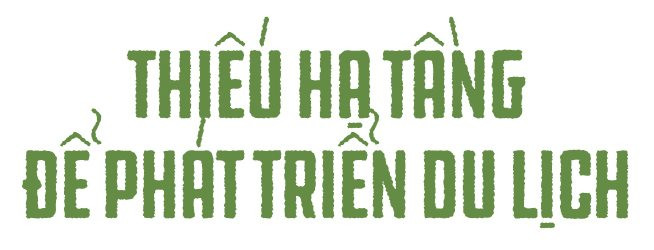
One of the concerns in craft villages and trade villages is not only maintaining stable economic activities but also the desire to transform these villages into tourist attractions, adding extra value to the local economy.
To achieve this, sustaining production activities is not enough; there needs to be clear regional planning in localities to create suitable spaces and landscapes for tourism development. Only then can the various attractions and experiences be connected, enticing tourists.
In the late afternoon sunlight, standing in the cultural and educational area of Nguyet Ang village (also known as the village of scholars with 11 doctors, 1 poinsettia, 30 doctoral degrees, and bachelors), Vice Chairman of the People’s Committee of Dai Ang commune (Thanh Tri district), Nguyen Van Hung, shares that Dai Ang has four distinctive villages. Among them are the hat-making village in Vinh Thinh, the tailoring craft in Vinh Trung, and the cultural heritage site of Nguyet Ang village. According to the local tourism development plan, the commune will expand and construct new facilities in the cultural and educational area, following the architectural style of three ancient structures, considering it the focal tourist point of the commune.
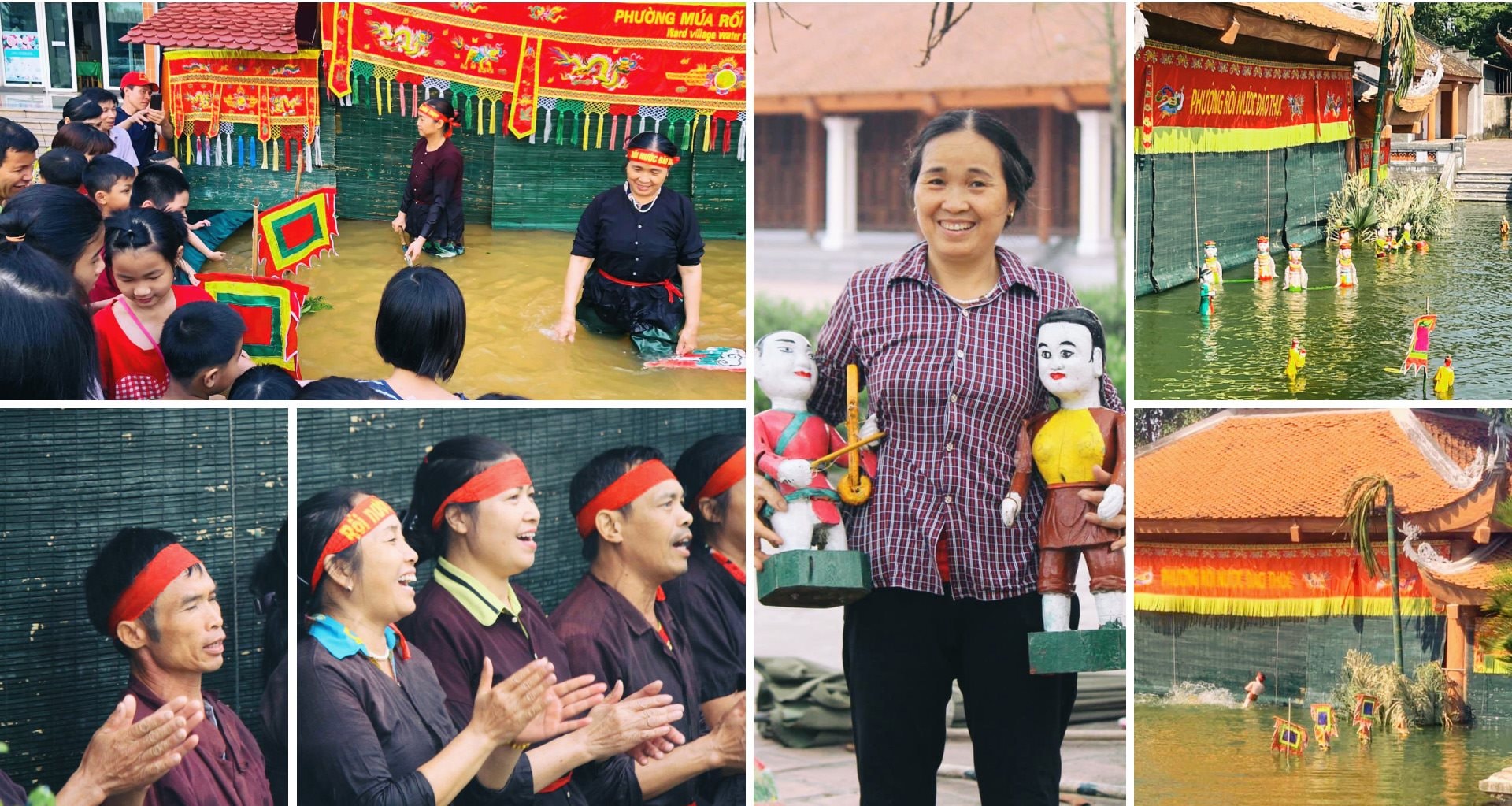
The performances of the Dao Thuc puppetry village (Thuy Lam commune, Dong Anh district) are always enthusiastically embraced by both locals and tourists.
“Dai Ang has been recognized by the city government as a tourist destination; however, the conservation of historical sites and the development of craft villages still face challenges. Due to the lack of prior planning, the land fund for constructing facilities and landscapes for tourism development in the commune is nearly depleted. The weak infrastructure also hampers the connectivity between tourist attractions,” candidly admits Mr. Nguyen Van Hung.
In the pursuit of transforming craft villages into tourist attractions, Nguyen Van Phi, the chief of Dao Thuc hamlet (Dong Anh district), shares the current deficiency in the Dao Thuc puppetry village – a lack of an authentically immersive rural experience.

“We dream of soon rebuilding the village gate with the iconic water puppetry model; a space for imparting skills to future generations and an entertainment area for visitors to not only watch puppetry but also experience it,” says Mr. Phi.
For Phu Dong, recently recognized as a City-level Tourist Destination by the city government, the village enjoys more advantages compared to others. It houses the UNESCO-recognized intangible cultural heritage event, the Giong Festival, within the nationally significant site of Den Giong. Additionally, its flower and ornamental tree cultivation, flourishing over the past 20 years, has yielded sweet fruits.
Nguyen Van Tai, Vice Chairman of the People’s Committee of Phu Dong commune, reveals that the locality has created green spaces, featuring highlights such as paper flower decorations along the levee leading into the village, creating a distinctive landscape. Despite these efforts, the commune’s leadership acknowledges the limitations in planning at Phu Dong, particularly in weak linkages between tourist destinations. The landscape and architecture of the village are not distinctive enough to attract visitors for a more immersive experience.
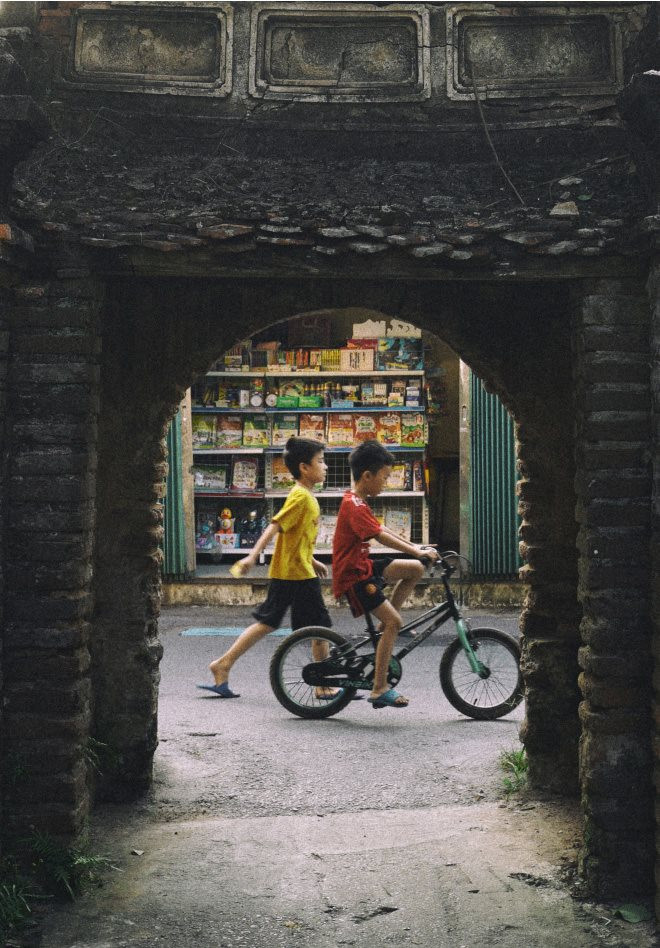
Preserving the ancient architecture of villages relies heavily on the youth of today.
Compared to traditional villages, the architectural planning of craft villages requires distinctiveness. It involves not only issues of surroundings and preserving the traditional heritage of the residents but also ensuring a safe, sanitary living environment and creating architectural connections, destinations, and economic value for the region.
Architect Ngo Ba Tuan expresses the viewpoint that rural architectural planning in craft villages needs to take a comprehensive view, respecting the local strengths in production. Localities, when mapping out planning, should focus on the distinctive features of each craft village, thereby constructing criteria for architecture suitable for living spaces, cultural spaces, and the unique nature of the craft village.
For instance, a puppetry craft village should have architectural structures related to puppetry symbols, while a hat-making craft village should feature public structures and peripherals with identifiable hat-making themes. The harmony of overall residential architecture with monuments, heritage sites, and cultural designs, as well as public constructions, will create the distinctive identity of rural villages.
Moreover, the landscape and architecture of craft villages need differentiation through a specialized system of visual, auditory, and crafting space signage related to the production of local residents. Visitors should have places for sightseeing and on-site experiences.
From a cultural and anthropological perspective, Dr. Nguyen Viet Chuc, Director of the Thang Long Cultural Research Institute, emphasizes that one of the significant factors influencing the transformation of rural architectural landscapes is the people.
The modernization and urbanization campaigns taking place vigorously in rural areas bring about a “change of skin and appearance” for these regions but also profoundly impact farmers due to the influence of urban culture. Economic conditions and changing mindsets of rural residents significantly affect changes in house architecture and family lifestyles. The spontaneous changes in lifestyle and production methods are also contributing factors to the gradual decline or disappearance of many craft villages.
Therefore, to establish better architectural and environmental landscapes in many craft villages, with distinctive characteristics, it is essential to first change the mindset and thinking of the residents. This requires the active involvement and support of local authorities in guiding and directing residents toward suitable production forms and regenerating living spaces and craft spaces based on specific conditions and circumstances.
Tran Hong Van, Hoang Le Quyen, Doan Anh Tuan, and Nguyen Huu Tiep
Bài 3: Tái tạo, bảo tồn không gian làng nghề (hanoimoi.vn)

